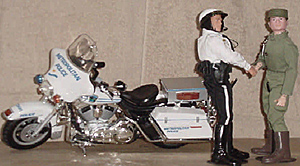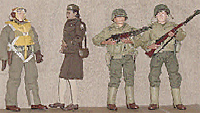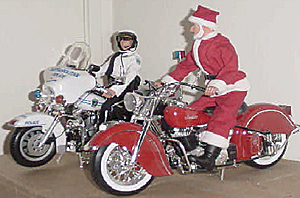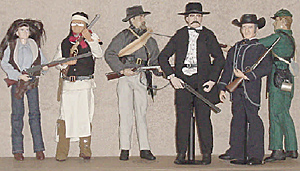 Hasbro introduced fully articulated 1:6th-scale “action figures” in 1964. The concept flourished for about a
decade, and then was consigned to the scrap heap of marketing history. Reasons given included oil shortage
(these soldiers were petroleum-based plastic), anti-war sentiment, and change in popular tastes. In plain and
simple English, Hasbro didn’t get the profits it wanted from G.I. Joe.
Hasbro introduced fully articulated 1:6th-scale “action figures” in 1964. The concept flourished for about a
decade, and then was consigned to the scrap heap of marketing history. Reasons given included oil shortage
(these soldiers were petroleum-based plastic), anti-war sentiment, and change in popular tastes. In plain and
simple English, Hasbro didn’t get the profits it wanted from G.I. Joe.
In 1977 Hasbro quit making 12-inch G.I. Joes. An 8-inch (1:9th-scale) Joe was briefly produced, but didn’t sell. Any kid could have told Hasbro why—there wasn’t enough 8-inch stuff around to make Joe’s world interesting. More successful was the 3.75-inch line launched in 1982, after the phenomenal success of “Star Wars” and its line of 3.75-inch action figures; and the syndicated G.I. Joe cartoon shows on television. The 1:6th-scale licensed Joes lingered on in overseas as South America’s Geyperman and Classicos Falcon, in Japan as G.I. Joe and Combat Man, and as England’s Action Man, but by the mid 1980’s most of these had become history.
Collectors revived the 12-inch G.I. Joe. Some just wanted to capture their lost childhood. Other “collectors” were really investors, hoping that the rotting plastic and ripped bits of fabric purchased for pennies at a garage sale would sell for hundreds of dollars to other collectors.
 Then there are the folks who just wanted to play.
Then there are the folks who just wanted to play.
We never left our childhood behind. In 1992, Hasbro re-entered the 12-inch market with a limited release of “Duke” from their popular television series. The market void was filled by an expensive, limited run company, Cotswold’s Elite Brigade, a company that specialized in “vintage G.I. Joe accessories.” Want to buy an original G.I. Jane? Got $4,000? Dragon Models Limited (famous for miniature airliners) came out with some World War Two figures at the end of the decade, setting a new standard for realism—at less than half the cost of Cotswold. Then there was 21st Century Toys and their “Ultimate Soldier” line—less expensive than Dragon, with more variety (though not as realistic or finely detailed).
By 1998, G.I. Joe was back with a vengeance.
I Play with Dolls
My initial professional experience with G.I. Joe as a tactical simulations training aid was in the Marine Corps Recruit Depot at San Diego, California in the summer of 1975. G.I. Joe was used at two stations in the formal First Phase knowledge test as a first aid dummy. Marines are famous for improvising on slender budgets—I hope that the remaining MCRD can afford full-size training dummies for first aid—but Joe worked for Heat Stroke and for Treat for Shock.
 MCRD San Diego used smaller Green Army Men to demonstrate and test for Fire Team
Formations. Later, I used war-gaming miniatures. There is a best ratio of figure size to simulated unit, and part of
the formula is how well the figures simulate reality. Prior to the personal computer age, war-gamers had to juggle
dice and paper tables and either markers or miniatures on game boards or terrain models. The age of Dungeons
and Dragons revitalized the 25mm miniatures, as the playing surface was about the size of a card table and
the unit size was about squad-level (with opposing forces often reaching company-sized combined arms).
MCRD San Diego used smaller Green Army Men to demonstrate and test for Fire Team
Formations. Later, I used war-gaming miniatures. There is a best ratio of figure size to simulated unit, and part of
the formula is how well the figures simulate reality. Prior to the personal computer age, war-gamers had to juggle
dice and paper tables and either markers or miniatures on game boards or terrain models. The age of Dungeons
and Dragons revitalized the 25mm miniatures, as the playing surface was about the size of a card table and
the unit size was about squad-level (with opposing forces often reaching company-sized combined arms).
In my experience, the 25mm figure is too small for individual-to-squad level due to lack of articulation in the figures and equipment limitations. For example, in the fantasy game of Dungeons and Dragons, those solid figures of roughly 1:72nd-scale were too tiny to assume proper poses. I could have several figures to represent the same character in different postures, or I needed a “posture card.” It makes a great deal of difference in game turns if the soldier is cowering behind full cover, protected fully but unable to observe the enemy, or if that soldier is standing at Parade Rest in full view of all and sundry.
Other problems had to do with clothing and equipment. Was the weapon deployed and ready or stowed for easy travel? Basically, each figure required a file folder, updated turn-by-turn. The problems of individual characters spurred computer gaming—too much detail to keep manual records of! A large enough figure can be that record-keeping device. Don Levine, G.I. Joe’s creator, chose the 12-inch format as large enough to conduct realistic individual play, yet small enough so that one figure would fit in a shoe box with adequate gear. A normal footlocker could store a full squad with equipment.
 I tried several figure sizes, but wound up using the 1:6th-scale figures for simulating traffic stops and room-clearing
drills. Today’s soldier or law enforcement officer can die simply by looking the wrong direction in urban
combat. Weapons must cover the assigned arc of fire, and be carried in the proper state: during World War
Two, some American soldiers were taught to move with fingers on triggers, ready to fire instantly, and some were
taught that the only “safe” way to move was with weapons unloaded, disassembled and cased. Neither, of
course, was the “best way” for all tactical movements—I have video reproductions of U.S. Army Second World
War training films addressing these issues.
I tried several figure sizes, but wound up using the 1:6th-scale figures for simulating traffic stops and room-clearing
drills. Today’s soldier or law enforcement officer can die simply by looking the wrong direction in urban
combat. Weapons must cover the assigned arc of fire, and be carried in the proper state: during World War
Two, some American soldiers were taught to move with fingers on triggers, ready to fire instantly, and some were
taught that the only “safe” way to move was with weapons unloaded, disassembled and cased. Neither, of
course, was the “best way” for all tactical movements—I have video reproductions of U.S. Army Second World
War training films addressing these issues.
“Training” is structured and synthetic experience. Simulating fire team operations in 1:1 scale takes more time and more space and more equipment to train from the ground up than does using miniatures and macros to illustrate key points—but eventually, it’s time to put away the toys and get dirty hands.
Displays
Bigger than war gaming is the display of authentic figures. If I had the space and the funds, I’d have a museum! The 1:6th-scale figures fit in better with my tight budget and small apartment. I have figures from various eras, including a Roman Legionnaire, America’s Civil War, the Great War and its sequel, the Second World War, and modern figures. Today’s “war on terrorism” isn’t new and unprecedented.Today’s front line soldier is likely to be a pimply-faced clerk in the local stop-n-rob or the custodial staff at a newspaper office. In the bad old “Dark Ages,” the local peasant was likely to be axed by warring bandits in order to deny information, aid and comfort to opposing gangs. In the 20th Century wars, especially the air war of 1935 to 1945 (known as the Second World War), the total war doctrine was that everyone was a legitimate target of aerial bombardment because the factory worker and farm hand contributed to a nation’s fighting strength.
In the wake of September 11, 2001, the demand for 1:6th-scale firefighters and uniformed police outstripped supply. Display pieces like this often are personal shrines to honor those who place themselves at risk for others. The availability of inexpensive 12-inch firefighter and law enforcement figures and their high degree of detail make them popular today. Last week, I saw a figure rigged out in Desert Camouflage Uniform standing on top of a Nevada National Guard recruiting sergeant’s bookshelf. At a recent Cross Roads of the West Gun Show, one table had a display of 12-inch fighting men. Six times larger than the popular 1:35th and 1:32nd scale dioramas, these 1:6th-scale displays concentrate more on individual persons than on small units or vehicles.
 In fact, most of the 1:6th-scale vehicles available are out of scale—sometimes badly out
of scale. Not really a problem for a dedicated model builder, except in terms of space. For the non-modeler, it
is now a simple thing to pick up a fire fighter figure and a small display case to honor public servants who do go in harms way.
In fact, most of the 1:6th-scale vehicles available are out of scale—sometimes badly out
of scale. Not really a problem for a dedicated model builder, except in terms of space. For the non-modeler, it
is now a simple thing to pick up a fire fighter figure and a small display case to honor public servants who do go in harms way.
Today, the variety of 12-inch figures and accessories is mind numbing. Type in “1:6th scale” on your internet browser and you’ll get thousands of hits. Try “G.I. Joe” and get more. Do you want realism? The miniature weapons can be detailed enough for firearms training—I did this in Kuwait with a large security force guarding a major American military logistics base.
Dragon’s M1 Rifle (the Garand) features operating bolt and the ability to insert the 8-shot Garand clip. Several other toy makers have followed suit. Most of the M16 and AK-47 miniatures feature detachable magazines— some have folding/telescoping stocks and functioning bayonet lugs and grenade launchers. No wonder California’s public school system has a zero-tolerance policy on these minature weapons—those well-educated faculty and staff members cannot tell these little toy guns from the real thing! I even have functioning 1:6th-scale handcuffs and briefcases in my collection.
G.I. Joe has returned, and he’s better than ever.
Back to Cry Havoc #40 Table of Contents
Back to Cry Havoc List of Issues
Back to MagWeb Master Magazine List
© Copyright 2002 by David W. Tschanz.
This article appears in MagWeb (Magazine Web) on the Internet World Wide Web. Other military history articles and gaming articles are available at http://www.magweb.com